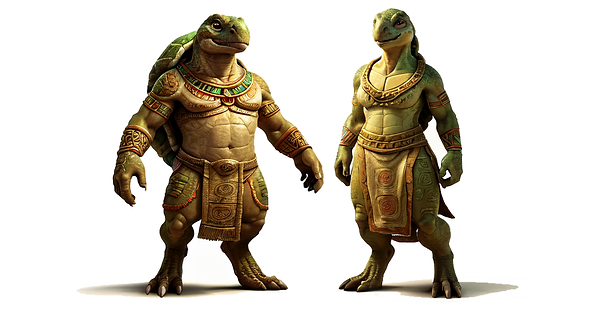SIAE Registration Protocol N° 2023/00696
Tortoises
The Tortoise people can be generally compared to a blend of Chichimeca and Acolhua society and members of the Testudinidae biological family.
Tortoises are one of the twelve races of anthropomorphic reptiles that populate Yanìs, and are grouped in the subgenus of Scaleds together with Crocodiles, Monitors and Turtles.
Physically, they are of medium height and exceptional weight due to their mighty carapace. On average, they can reach and exceed 5 feet in height and a weight of well over two tons. They are also one of the longest-lived Anthro races ever, with an average lifespan that exceeds one century. They have a large bony shell of a dull brown or grey color. Legs and arms are large and stumpy, with dry, scaly skin and hard scales, and they can withdraw their head, neck, and limbs into their shell for protection. Tortoises keep a characteristic scute pattern on their shells throughout life, and size and shape of their shell vary depending on their environment. In humid highlands, they are larger, with domed shells and short necks, while in dry lowlands, they are smaller, with "saddleback" shells and long necks. Females have a more elongated and wider carapace shape than males. Furthermore, sometimes lichens can grow on the shells of these slow-moving Anthros. They reproduce by oviparity, with females laying a pair of eggs in a sandy basin after fertilization occurs through sexual acts.
Tortoise people were a semi-nomadic population that settled in western Sephyr only shortly before the arrival of the Wyvern rulers. They defeated Armadillo people by forcing them to leave Sephyr and move to Mogress. Then, they settled in the valley between larger volcanoes, and this population of farmers-gatherers undertook a process of sedentarization and cultural integration that lasted until the birth of the actual Korzatcal. At the time of the Wyverns' arrival, Tortoise people's territory was divided into four main sections, grouped into local administrative centers called calputti. Each local unit nominated its own military, religious, and civil leaders, respecting the will of calputti representatives expressed in assemblies.
One of the most surprising aspects of Tortoise people is their architectural achievements, quickly learned after settling. Their cities are now filled with huge temples and palaces, with some having up to 80 large buildings, each with a different purpose and flanked by crops. Temples were consecrated to various deities, but most were then reassigned to the cult of Zundoey. Their dwellings are built of wood and clay bricks with reed roofs, while pyramids, temples, and palaces are usually made of carved stone.
They speak Erpeton language, common to all Anthro reptile races, a harsh, hissing language, spoken mostly in the southern hemisphere of the planet (perhaps an Arabic gibberish).
Religiously they were mostly devoted to Najan (deity of community and agriculture), Vael Nhor (deity of knowledge and memories), and Ekoari (deity of science and commerce), but since the coming of their Wyverns rulers the main cult has become that of Zundoey (deity of undeath, curses and oblivion), also some Druidic and Lohudonist cults keep tarrying.
Their Ancestral Princes were Nanauatl and Sahagún, who taught their race that calmness and slowness are positive qualities, not disadvantages as many would think. Tortoise people are perhaps the most long-lived of all, and therefore, a Tortoise should never worry about being in a hurry; everything happens in its own time, and every creature responds to the outside world in the most appropriate way. However, slowness is not a distinctive trait but a talent that must be learned through experience and wisdom.
